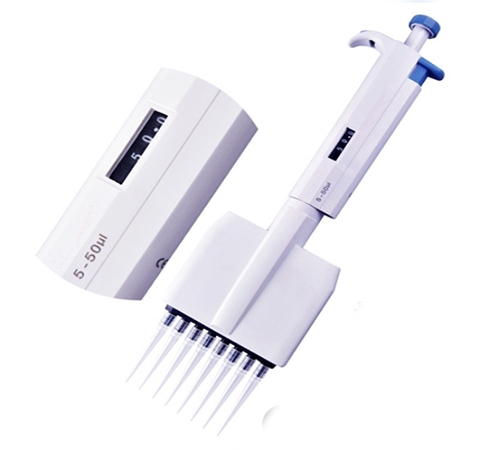Troubleshooting of Pipettes
Pipette, also known as pipette gun, is a kind of instrument used to transfer liquid quantitatively. It is widely used in biology, chemistry and other fields. Pipette is vulnerable, and its damage is generally divided into man-made damage or operation damage. Please follow these steps below. In addition, small-volume pipettes usually have very small components, which will be damaged or lost easily, thus requiring special attention.
Liquid leakage
1. If the gun well matches.
2. If the spring piston is in normal conditions.
3. If it is a volatile liquid, it may be a problem caused by saturated vapor pressure. You can aspirate and release the liquid several times before pipetting.
Low pipetting volume is a common problem, and there are many causes. How to judge whether the  volume is too low, you can follow the following four steps.
volume is too low, you can follow the following four steps.
The first step is to check the sucker, which means to inspect the installation and deformation of the sucker, or you can install a normal new sucker to confirm if the volume is still low. If the condition is not improved, please go to the second step.
The second step is to check the handle, and check whether the part where the handle and the suction head are combined is smooth. If there are minor scratches or rough hand feelings caused by long-term friction with the tip, it is recommended to replace the handle (if you want to replace the handle, please hand it to the supplier, then the supplier can also check the piston system when replacing the sleeve handle). Then, it is required to check whether the sleeve handle is blocked (when the aspiration volume is very small or even unable to aspirate at all, it is likely to be blocked). At this time, you need to remove the sleeve handle (be careful in this process to avoid losing the small parts on the piston system), and turn the larger diameter end of the sleeve handle toward your eyes, and the smaller diameter toward the brighter direction. If no bright spot can be seen in the sleeve, it is proved to have blocked. At this time, a thin metal wire can be used to clear the handle. After confirming no abnormality in the sleeve handle, confirm whether the problem of low pipetting volume still exists. If there is no improvement, please go to the third step.
The third step is to check the air tightness of the pipette. First, it is required to set the pipette range and install the sucker. For pipettes with a volume of 200ul and above, after absorbing pure water, you have to hold it vertically in the air for more than 15 seconds to see if water droplets form or even drip from the sucker. If no change appears, the air tightness is proved to be good. For pipettes with a volume of less than 200ul, after absorbing pure water, you need to keep the sucker tip under the water for more than 15 seconds to see if the liquid level in the tip drops. If there is no drop, the air tightness is proved to be good. If the air tightness of the pipette is good, but the pipetting volume is too small, the pipette is suggested to be delivered to the supplier to adjust the quantitative screw. If the air tightness is still not good, go to the fourth step.
The fourth step is to check the piston system. After disassembling the piston, it is required to check if the piston is polluted, clean the piston, smear lubrication oil, re-install the piston, and recheck if the pipetting volume is still low. If the problem can not be solved, please deliver to the supplier. If there are serious problems such as aging of the sealing ring or rust of the piston, please also send it to the supplier for handling. Generally, users are not recommended to replace the accessories after purchasing the accessories from the supplier.
Sample splash (liquid enters the inner pipette)
Remove the sucker pushing arm (press the button of sucker exiting, press down the exposed "butterfly piece" on the upper end of the sucker pushing arm, and pull it out along the direction of the handle, please refer to the operating instructions for details), unscrew the toggle coupling and remove the toggle.
Check whether the sealing device and piston are polluted. The piston should be glossy and free of corrosive rust. If it is contaminated, clean it with distilled water or isopropyl alcohol, and then wipe it with a non-woven cloth. At the same time, note that before re-installing, check whether the inner wall of the handle is clean and ensure that all parts are completely dry.
If the internal piston is corroded or severely contaminated, the pipette can no longer be used and it should be sent to the after sales service department for disposal.
Except for 10ml and 20ml pipettes, a little lubricating oil is required on the sealing parts, and there is no need to grease any parts of other pipettes.
Air leakage, inaccurate sampling
Loose toggle: Slightly tighten manually.
Toggle breakage: Disassemble the sucker pusher, check the toggle (replace the new toggle if necessary). Disassemble the toggle, check the condition of the piston. In case of a bending, the pipette shall be sent to the after sales service department.

